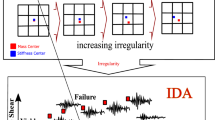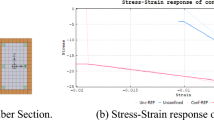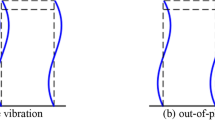Abstract
Pushover analysis has been recommended as a reliable tool to estimate the seismic capacity of the structures. Vertical irregular structures are highly vulnerable during earthquakes due to stiffness irregularity in their elevations. Hence, seismic capacities of these types of structures need to be re-estimated during structural design stage. So, in this paper, an attempt has been made to assess the actual seismic performance of buildings with two common types of vertical irregularities such as; soft story and setback in comparison with regular (reference) building. These types of vertical irregularities are studied in individual cases, combined in one story, and combined in two different stories of the building models, while most previous studies satisfy with individual type of vertical irregularity case in the studied model. In addition, combined vertical irregularity generates extra weak points, which alter the seismic capacities, failure mode mechanism, and performance point location. Three-dimensional numerical models are created to find out significant response demand such as; the variation in periods of vibration, lateral displacement, inter-story drift, pushover curve, and plastic hinges formation. The results showed that vertical irregular buildings are subjected to early damages and have less seismic capacity than regular one. The fundamental time period becomes misleading term in seismic force calculation for vertical geometric irregular buildings and needs to be re-considered. In addition, extra lateral displacement and inter-story drift are passively generated in the vertical irregular buildings due to sudden change in stiffness. Significant negative variation in the pushover curves, ductility ratios, and plastic hinges’ formation is observed when combinations of pre-mentioned vertical irregularity cases occur. Buildings with open soft ground story with asymmetric setback should have additional precautions from international codes during structural design stage according to their irregularity ratio. Therefore, response modification/reduction factor (R) may be scaled-down to adapt these negative variation in seismic capacities.















Similar content being viewed by others
References
Mwafy, A.; Khalifa, S.: Effect of vertical structural irregularity on seismic design of tall buildings. Struct. Des. Tall Spec. Build. 26(18), 1399 (2017)
Herrera, R.G., Gómez-Soberón, M.C.: Influence of plan irregularity of buildings. In: The 14th World Conference on Earthquake Engineering (2008)
Abdel Raheem, S.E., Ahmed, M.M.M., Ahmed, M.M., Abdel-shafy, A.G.A.: Seismic performance of L-shaped multi-storey buildings with moment-resisting frames. In: Proceedings of the Institution of Civil Engineers (ICE), pp. 1–14 (2017)
Abdel Raheem, S.E.; Ahmed, M.M.M.; Ahmed, M.M.; Abdel-shafy, A.G.A.: Evaluation of plan configuration irregularity effects on seismic response demands of L-shaped MRF buildings. Bull. Earthq. Eng. 16, 3845–3869 (2018)
Zadeh, B.M.; Kang, J.: Seismic analysis of high-rise steel frame building considering irregularities in plan and elevation. Steel Compos. Struct. 39(1), 65–80 (2021)
ACUD: Report for New Adminisrative Capital Development. (2016). https://www.ecrg.de/images/Download_pdf/Brochure.pdf
Rakshith Gowda, K.R.; Shankar, B.: Seismic analysis comparison of regular and vertically irregular RC building with soft storey at different level. Int. J. Emerg. Technol. Eng. (IJETE) 01(06), 157–164 (2014)
Sayyed, O.; Kushwah, S.S.; Rawat, A.: Seismic analysis of vertical irregular RC building with stiffness and setback irregularities. IOSR J. Mech. Civ. Eng. 04(06), 40–45 (2017)
Zabihullah, P.S.; Aryan, M.Z.: Effect of (vertical & horizontal) geometric irregularities on the seismic response of RC structures. Int. J. Emerg. Technol. 11(3), 965–974 (2020)
Favvata, M.J.; Naoum, M.C.; Karayannis, C.G.: Limit sates of RC structures with first floor irregularities. Struct. Eng. Mech. 47(6), 791–818 (2013)
Favvata, M.J.; Karayannis, C.G.: Influence of pinching effect of exterior joints on the seismic behavior of RC frames. Earthq. Struct. 6(1), 89–110 (2014)
Ehab, M.; Maxi, M.: Assessment of SMC frames under different column removal scenarios. Civ. Eng. J. 6(2), 285–303 (2020)
Ghosh, R.; Debbarma, R.: Performance evaluation of setback buildings with open ground story on plain and aloping ground under earthquake loadings and mitigation of failure. Int. J. Adv. Struct. Eng. 9(2), 97–110 (2017)
Asıko, A.; Vasconcelos, G.; Lourenco, P.B.: Overview on the nonlinear static procedures and performance-based approach on modern unreinforced masonry buildings with structural irregularity. Buildings 11(147), 1–33 (2021)
Karayannis, C.G.; Favvata, M.J.; Kakaletsis, D.J.: Seismic behaviour of infilled and pilotis RC frame structures with beam-column joint degradation effect. Eng. Struct. 33(10), 2821–2831 (2011)
Rastegarian, S.; Sharifi, A.: An investigation on the correlation of inter-story drift and performance objectives in conventional RC frames. Emerg. Sci. J. 2(3), 140–147 (2018)
Al-Mamun, A.: Seismic damage assessment of reinforced concrete frame buildings in Canada, Ph.D, ed. F. o. E. Department of Civil Engineering, University of Ottawa (2017)
Chiranjeevi, R.; Ramyakala, S.; Venugopal, M.; Anusha, N.: Seismic performance of flat slab with drop and conventional structure. Int. J. Eng. Res. Technol. (IJERT) 05(10), 283–295 (2016)
El-Betar, S.A.: Seismic Performance of existing RC framed buildings. Hous. Build. Natt. Res. Center HBRC J. 13, 171–180 (2017)
ATC-40: Seismic evaluation and retrofit of concrete buildings. Applied Technology Council, p. 346 (1996)
FEMA-273: Guideline for the seismic rehabilitation of buidlings. Federal Emergency Management Agency, Washington, DC, p. 435 (1997)
Ashwini, K.C.; Manjunath, Y.M.: Comparative study of pushover analysis on RCC structures. Int. J. Eng. Res. Technol. (IJERT) 6(7), 71–79 (2017)
Bhatti, A.Q., Varum, H.: Application of performance based nonlinear seismic design and simulation static pushover analysis for seismic design of RC buildings. In: 15th World conference on earthquake engineering, WCEE (2012)
Abd-Elhamed, A.; Sayed, M.: Nonlinear static analysis of reinforced concrete framed buildings—a case study on cairo earthquake. J. Eng. Res. 4(4), 16–38 (2016)
Mohamed, W.-W.; El-Naiem, M.A.A.: Seismic evalution and retrofit of an asymmetric reinforced concrete flat slab building. J. Eng. Sci. Assiut Univ. 36(2), 313–335 (2008)
Saloma, S.; Yakni Idris, B.; Hanafiah, H.; Nico Octavianus, M.: Structural behaviour of steel building with diagonal and chevron braced CBF (concentrically braced frames) by pushover analysis. Int. J. Adv. Sci. Eng. 7(2), 716–722 (2017)
Hirde, S.; Tepugade, G.: Seismic performance of multistorey building with soft storey at different level with RC shear wall. Int. J. Curr. Eng. Technol. 04(03), 2019–2023 (2014)
Waleed, A.E.; Mohamed, W.: Seismic capacity of RC hollow block slab building and retrofitting systems. J. Eng. Sci. Assiut Univ. 4(3), 629–651 (2014)
Cho, B.-H.; Hong, S.-G.; Ha, T.-H.; Kim, D.-J.: Seismic evaluation of asymmetric wall systems using a modified three-dimensional capacity spectrum method. JVE Int. LTD. J. Vibro Eng. 17(08), 4366–4376 (2015)
Rao, P., Balaji, K., Raju, G., Rao, S.: Nonlinear pushover analysis for performance based engineering design—a review. Int. J. Res. Appl. Sci. Eng. Technol. (IJRASET) 05(03), (2017)
Kalkan, E., Kunnath, S.K.: Method of modal combinations for pushover analysis of buildings. In: 13th World Conference on Earthquake Engineering, Vancouver, Canada, p. 2713 (2004)
Chopra, A.K., Goel, R.K.: A modal pushover analysis procedure for estimating seismic demands for buildings: theory and preliminary evaluation. In: PEER Report 2001/2003, Pacific Earthquake Engineering Research Center, College of Engineering, University of California, Berkeley (2001)
Chopra, A.K.; Goel, R.K.: A modal pushover analysis procedure for estimating seismic demands for buildings. Earthq. Eng. Struct. Dyn. 31(3), 561–582 (2002)
Chopra, A.K., Goel, R.K.: A modal pushover analysis procedure to estimate seismic demands for buildings: summary and evaluation. In: 5th National Conference on Earthquake Engineering, Istanbul, Turkey (2003)
Fallah, N.; Pourze Ynal, S.; Hafez, M.I.: Accuracy evaluation of the modal pushover analysis method in the prediction of seismic response of vertically irregular frames. IJST Trans. Civ. Eng. 35(2), 171–184 (2011)
Chopra, A.K.; Goel, R.K.: Evaluation of NSP to estimate seismic deformation: SDF systems. J. Struct. Eng. 126(4), 482–490 (2000)
Warnitchai, P., Mehmood, T., Suwansaya, P., Najam, F. A.: Seismic Performance Evalution of Tall Buildings Using Modal Decomposition Approach. In: 6th ASIA Conference on Earthquake Engineering (6ACEE) (2016)
Hakim, R.A.; Alama, M.S.; Ashour, S.A.: Seismic assessment of RC building according to ATC 40, FEMA 356 and FEMA 440. Arab. J. Sci. Eng. 39(11), 7691–7699 (2014)
FEMA-424: Design guide for improving school safety in earthquakes, floods, and high winds. Risk management series. Federal Emergency Management Agency, Washington, DC, p. 361 (2010)
FEMA-356: Prestandard and commentary for the seismic rehabilitation of buildings. Federal Emergency Management Agency, Washington, DC, p. 518 (2010)
Manohar, S., Madhekar S.: Seismic Design of RC Buildings. Springer Transactions in Civil and Environmental Engineering (2015)
Barbude, P.; Momin, M.F.; Boob, T.N.: An overview of seismic performance of reinforced concrete frame for vertically irregular buildings. Int. J. Eng. Technol. Manag. Appl. Sci. 05(05), 70–75 (2017)
Uros, M.; Prevolnik, S.; Novak, M.S.; Atalic, J.: Seismic performance assessment of an existing RC wall building with irregular geometry: a case-study of a hospital in Croatia. Appl. Sci. 10(5), 1–36 (2020)
Murty, C.V.R., Goswami, R., Vijayanarayanan, A.R., Mehta, V.: Earthquake Behaviour of Buildings. Gujarat State Disaster Management Authority, Gandhinagar (2012)
ASCE-7: Minimum Design Loads for Buildings and Other Structures. American Society of Civil Engineers, p. 658 (2010)
8, Eurocode: Design of structures for earthquake resistance-Part 1 : General rules, seismic actions and rules for buildings (2004)
ECOL-201: Egyptian code for calculating loads and forces in structural work and masonry. Housing and Building National Research Center, Ministry of Housing, Utilities and Urban Planning, Cairo, Egypt, p. 230 (2012)
CSI: ETABS, Integrated Building Design Software, Computers and Structures, Inc., Berkeley, California (2016)
ECOP-203: Egyptian Code of Practice for Design and Construction of Reinforced Concrete Structures, ECPCS-203. Housing and Building National Research Center, Ministry of Housing, Utilities and Urban Planning, Cairo, Egypt (2018)
Izzuddin, B.A.: Nonlinear Dynamic Analysis of Framed Structures, PhD thesis. Department of Civil Engineering, Imperial College, University of London (1991)
ECOL-201: Egyptian code for calculating loads and forces in structural work and masonry. Housing and Building National Research Center, Ministry of Housing, Utilities and Urban Planning, Cairo (1993)
IBC: International Building Code. International Code Council, INC (2003)
UBC: Uniform building code, vol. 2: Structural engineering design provisions. In: International Conference of Building Officials (ICBO), Whittier, California, p. 545 (1997)
Raheem, A.; Shehata, E.: Evaluation of Egyptian code provisions for seismic design of moment-resisting-frame multi-story buildings. Int. J. Adv. Struct. Eng. 5(20), 1–18 (2013)
Author information
Authors and Affiliations
Corresponding author
Rights and permissions
About this article
Cite this article
Ahmed, M.M.M., Abdo, M.AB. & Mohamed, W.A.EW. Vertical Geometric Irregularity Effect on Performance-Based Seismic Design for Moderate Rise RC Moment Resisting Frame Buildings. Arab J Sci Eng 47, 12333–12348 (2022). https://doi.org/10.1007/s13369-021-06376-y
Received:
Accepted:
Published:
Issue Date:
DOI: https://doi.org/10.1007/s13369-021-06376-y




